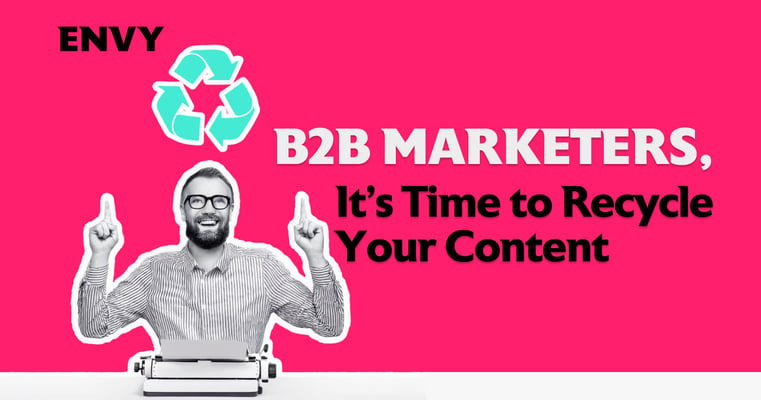
7 creative ways to repurpose B2B tech content
Solid, valuable content creation takes time. Of course it does. But if you’re creating new content for every campaign or initiative from scratch, it becomes a time drain. You’re working harder, not smarter. So we say: stop creating, start recycling. Giving existing assets a second (third, fourth and fifth) life can help you get the results you’re after while still leaving extra time for other tasks.
But… content recycling is more than just copying and pasting across different pages. So today we’re looking at all the ways we recycle our content at Envy, so that you can do it too.
Hold on, why do I have to recycle?
Here’s the kicker that really gets us every single time—once you hit publish, that content is NEVER finished for you. It’ll always need more work. The goal is to maximize the ROI on your efforts, and repurposing your content is the secret sauce to doing just that. Why?
- Do more with less, obvious.
- More content formats = more SEO juice. Google will love you for it, and so will your site traffic. Just make sure individual pieces don’t cannibalize each other for certain keywords 😉 With AI impacting search rankings, you’ll want every opportunity to rank higher and draw in traffic.
- Buyers need multiple touchpoints before they take action. Repurposing helps you hammer home your message without sounding repetitive.
- Reach prospects in their format of choice. Blogs are great, but not everyone loves reading. Different formats = more reach. This is especially useful when writing content for PPC campaigns.
Does that mean I should repurpose all my content now?
We hate to be the bearers of bad news, but simply put–no. Not every content piece deserves to be recycled. So here’s how you choose the right content to repurpose:
- Top performers first. Check your analytics. What blogs or assets are already driving traffic and conversions? Start there.
- Stick to evergreen. Repurpose content that stays relevant over time—think how-tos or industry insights, not last quarter’s trends.
- Fill funnel gaps. Missing a killer middle-funnel piece? Mix a top-funnel blog with a case study or product one-pager to move leads down the pipeline.
- Match it to your audience. Know where your prospects hang out. Busy execs love digestible videos and slide decks. LinkedIn crowd? Make it a carousel.
7 ways to recycle your B2B marketing content
We’re gonna make it easier and assume you already have an existing ebook, say it’s The big book of tips for B2B marketers that performs well. These are usually packed with knowledge and keywords, and that’s always a good start. We have 7 ways you can reuse that ebook, but before that–a super handy content recycling table you can use for every single asset you create:
|
eBook Recycling Table |
Action |
|
Blog 1 (pick a segment of the ebook) |
V |
|
Blog 2 |
V |
|
Blog 3 |
V |
|
Video/s |
V |
|
Webinar |
X |
|
Social posts |
V |
|
Sales tool 1 |
V |
|
Sales tool 2 |
V |
|
Sales tool 3 |
X |
|
Email nurtures |
V |
|
Website page/quotes/case study |
X |
|
Newsletter |
V |
So here’s 7 ways you can recycle that ebook:
1. Turn ebooks into blog posts–and vice versa
Look, we’re advocates for ungated content. Making all your content pieces accessible and sharing free knowledge with no strings attached helps build brand awareness and trust.
But we all need leads to nurture–that’s why, if you’ve written several blog pieces on one subject, there’s no need to reinvent the wheel and create an entire ebook from scratch. Combine those blog posts, give them a solid structure, add any necessary updates, and design a simple, downloadable ebook.
The opposite is also true. An ebook or whitepaper can easily be broken down into 3 -4 standalone blog posts (that we often use to promote the original ebook/whitepaper). Recycling <> cyclical thing.
2. Videos
Your videos don’t require professional videographers! Also, you don’t need shooting days to record more. In fact, authentic videos sell best–sure, you still need to edit it nicely, but don’t think about it too much. Just sit in front of the camera and say what you’ve got to say.
Record short videos where you highlight the key takeaways from a blog post, add any new insights or tips relevant to your audience. Share these videos on LinkedIn, in your newsletters, or even use them in outbound sales emails. And then use them to write new blog posts 😉
3. Webinars & podcasts
This one works both ways.
Attended a webinar or spoken on a podcast? Write a blog piece based on your presentation.
Have been invited to attend a webinar or speak on a podcast? Use the topic you’ve already written about.
That’s what we do. See the conversation with Pe’era Feldman below? We turned it into a blog post about why ABM doesn’t deserve the hype it gets.
4. Post it on social
This one’s pretty obvious. You have a new ebook, you promote it on social. That’s how it works, right?
True, but there are still ways that can get you better visibility & higher engagement:
- Pick out the best stats, insights, or quotes from the blog post and present them in a visual format. You know what they say, humans are visual creatures;
- Carousels! Build a story that keeps people swipe until the last card. But here’s the thing–don’t leave the best for last. Start with your strongest hook, and finish with a CTA;
- Thought leadership. We just cannot get enough of this. Your C-level management are people that actually drive engagement on platforms like LinkedIn, not your brand profile.
5. Sales Collateral
Sales teams don’t get enough love from marketing, it’s a tale as old as time. They create their own content, go completely off brand and make your blood boil. Raise your hand if you’ve never edited a last minute PowerPoint presentation full of stock images to send to a prospect. Here’s how we can change that:
For every industry you target, or product/service you offer, use your existing content to create downloadable assets or tools for sales enablement. We’re talking BOFU prospects here, people who need hard evidence of your work in order to move forward, so give them assets that deliver. Think about:
- Breaking down reports into digestible points
Long reports or case studies can be intimidating. Do your prospects want to go over a full 30-page document to learn about your company? Would you? So break it down. Highlight key data points, success metrics, or actionable insights that align with your prospect’s specific pain points.
- Answering the most burning questions your target audience is asking
Your SDRs are already fielding these questions. Make their lives (and your prospects' decision-making) easier by creating collateral that directly addresses these recurring queries. Create FAQ one-pagers, cheat sheets, or infographics. Not only does this arm your sales team with ready-to-go answers, but it also saves your prospects from digging through Google. And guess what? It helps SEO like your page better too.
- Turning case studies into targeted one-pagers
We all know case studies are gold, but a 7-page deep dive isn’t ideal for a prospect (or anyone, really). Instead, create punchy one-pagers for each industry you target, focusing on results and key takeaways. This helps prospects get a better picture of their success without having to dig through dense content, AND helps your SDRs to easily walk through phone calls. Keep it focused on the impact: problem > solution > results, and make sure it’s visually appealing (aka don’t just slap text on a page).
- Offering ROI calculators, or easier-to-digest slide decks
Spreadsheets aren’t sexy, period. Instead of sending a bulky report, build an interactive ROI calculator that gives your prospects an instant sense of how your solution impacts their bottom line. Better yet, create slide decks that tell the ROI story in a way that’s visually engaging and easy to follow.
6. Add more meat to your newsletter
You know what happens with newsletters that serve as company updates, or lists of most recent blogs? They get high bounce & unsubscribe rates.
And you know what happens with newsletters full of links and CTA buttons? First, mail providers put them to spam or that long forgotten “Offers” folder no one ever checks. Second, even if it does go through to people’s inboxes, they get overwhelmed and end up clicking… nothing.
What you can do instead is pick one subject you’ve recently spoken or written about and dive deeper into it. Choose just one blog piece you wanna link to and offer even more knowledge than you already shared, add more stats, or your C-level’s thoughts on the matter.
Instead of using your newsletter as updates on what’s been happening (people already know, they most likely follow you on LinkedIn anyway), make readers excited about your emails.
Don’t forget about nurture workflows
If newsletters are like that reliable friend who keeps checking in to see how you’re doing—then nurture workflows keep reminding you that your company could be doing a lot better with the right tools or services 😉
Instead of sending just one email every one in a thousand years, build sequences that can turn lukewarm leads into flaming hot MQLs ready to hand over to sales. Each email can focus on one key point, leading the reader further down the rabbit hole until they’re hungry for more—like your ebook, webinar, or the one thing we’re all after, product demo.
7. Optimize evergreen content for SEO
Every few months, open Google Search Console, Semrush, dashboards on HubSpot, or whatever you use to track content performance, and search for older blogs that show steady traffic (meaning even number or views & clicks despite the time) – and update them. Add fresh links from and to the piece, make sure the stats and quotes are still relevant, or that the visuals are on brand. This also gives your sales team something fresh to share with prospects.
This tells search engines those content pieces are relevant and valuable, but it also allows you to reshare it with your audience. Keeping both SEO & actual readers happy is your goal.
And something extra, because we’re nice like that, make sure your content never competes against each other for specific keywords. Two blog pieces on the 2nd page on Google are great, but not as great as one solid piece on the 1st page. Combine them, redirect, or simply edit to target different keywords.
Recycling content is one of the easiest ways to make sure you’re getting the most out of your B2B content efforts. The next step is proper content distribution 😉 If you need help to build out a more effective strategy, see how our inbound marketing services can help you execute these ideas (and more).







